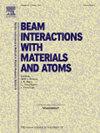测量锆的质子弹性散射截面和厚 ZrDx 薄膜中的氘分布
IF 1.4
3区 物理与天体物理
Q3 INSTRUMENTS & INSTRUMENTATION
Nuclear Instruments & Methods in Physics Research Section B-beam Interactions With Materials and Atoms
Pub Date : 2024-11-22
DOI:10.1016/j.nimb.2024.165576
引用次数: 0
摘要
为了精确量化重要深度的氘(D)浓度并加深对锆(Zr)薄膜中氘分布的理解,我们在金/锆/钛薄膜上测量了锆的质子弹性散射截面。测量在 165° 和 170° 的实验室角度下进行,能量范围为 1.5-5.0 MeV。在质子能量超过 4.43 MeV 时观察到了非卢瑟福散射。通过结合不同能量下的质子反向散射 (PBS) 和核反应分析 (NRA),我们实现了对氘化锆薄膜内 D 浓度的高精度量化,深度分辨率低于 500 纳米。此外,我们还对 ZrDx/Mo 薄膜中的锌、钼和 D 原子浓度进行了初步评估,为今后的研究奠定了基础。本文章由计算机程序翻译,如有差异,请以英文原文为准。
Measurement of proton elastic scattering cross-section of Zr and deuterium distribution in thick ZrDx films
To precisely quantify the deuterium (D) concentration at significant depths and enhance the understanding of D distribution in zirconium (Zr) films, the proton elastic scattering cross-section of Zr was measured on an Au/Zr/Ti thin film. The measurement was conducted at laboratory angles of 165° and 170° over an energy range of 1.5–5.0 MeV. Non-Rutherford scattering was observed at proton energies exceeding 4.43 MeV. By combining proton backscattering (PBS) and nuclear reaction analysis (NRA) at different energies, a highly precise quantification of D concentrations within deuterated zirconium film, with depth resolution below 500 nm, was achieved. Additionally, we established initial assessments of Zr, Mo, and D atom concentrations in the ZrDx/Mo film, laying the groundwork for future studies.
求助全文
通过发布文献求助,成功后即可免费获取论文全文。
去求助
来源期刊
CiteScore
2.80
自引率
7.70%
发文量
231
审稿时长
1.9 months
期刊介绍:
Section B of Nuclear Instruments and Methods in Physics Research covers all aspects of the interaction of energetic beams with atoms, molecules and aggregate forms of matter. This includes ion beam analysis and ion beam modification of materials as well as basic data of importance for these studies. Topics of general interest include: atomic collisions in solids, particle channelling, all aspects of collision cascades, the modification of materials by energetic beams, ion implantation, irradiation - induced changes in materials, the physics and chemistry of beam interactions and the analysis of materials by all forms of energetic radiation. Modification by ion, laser and electron beams for the study of electronic materials, metals, ceramics, insulators, polymers and other important and new materials systems are included. Related studies, such as the application of ion beam analysis to biological, archaeological and geological samples as well as applications to solve problems in planetary science are also welcome. Energetic beams of interest include atomic and molecular ions, neutrons, positrons and muons, plasmas directed at surfaces, electron and photon beams, including laser treated surfaces and studies of solids by photon radiation from rotating anodes, synchrotrons, etc. In addition, the interaction between various forms of radiation and radiation-induced deposition processes are relevant.

 求助内容:
求助内容: 应助结果提醒方式:
应助结果提醒方式:


